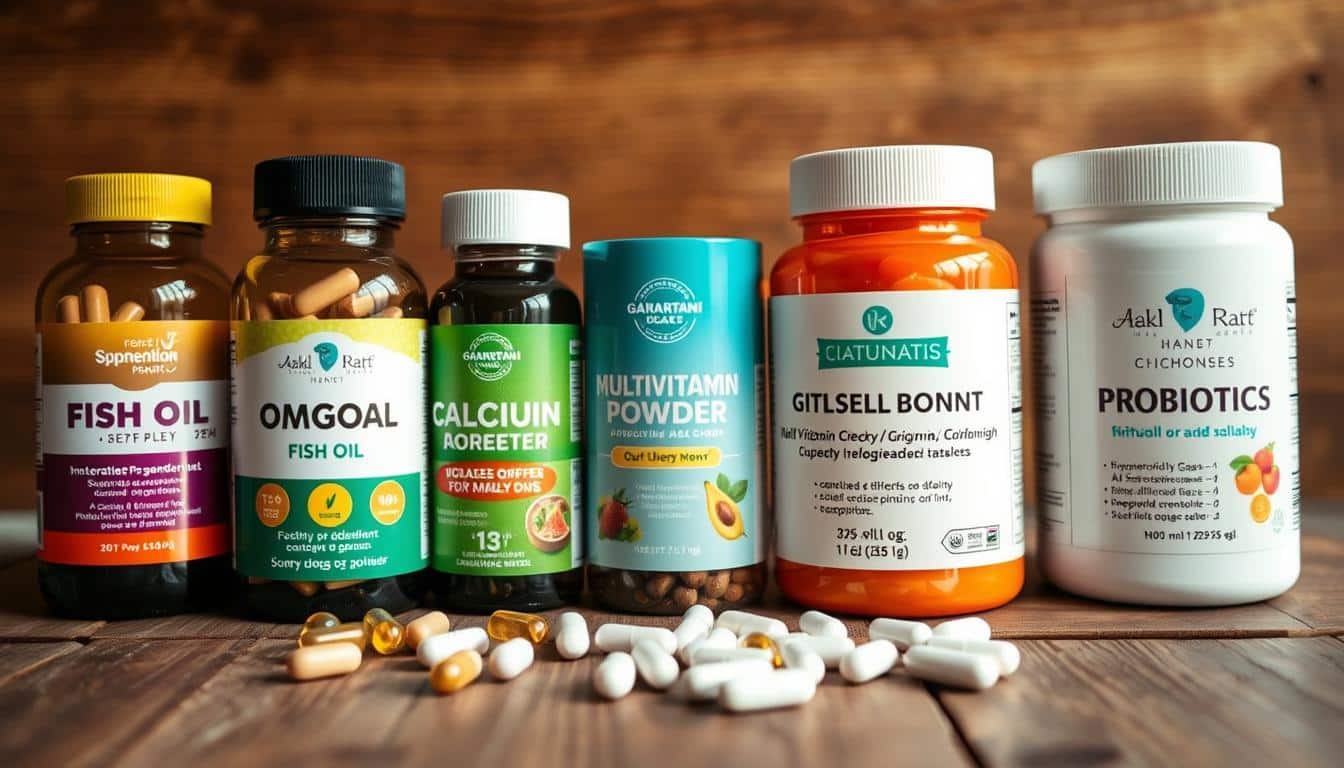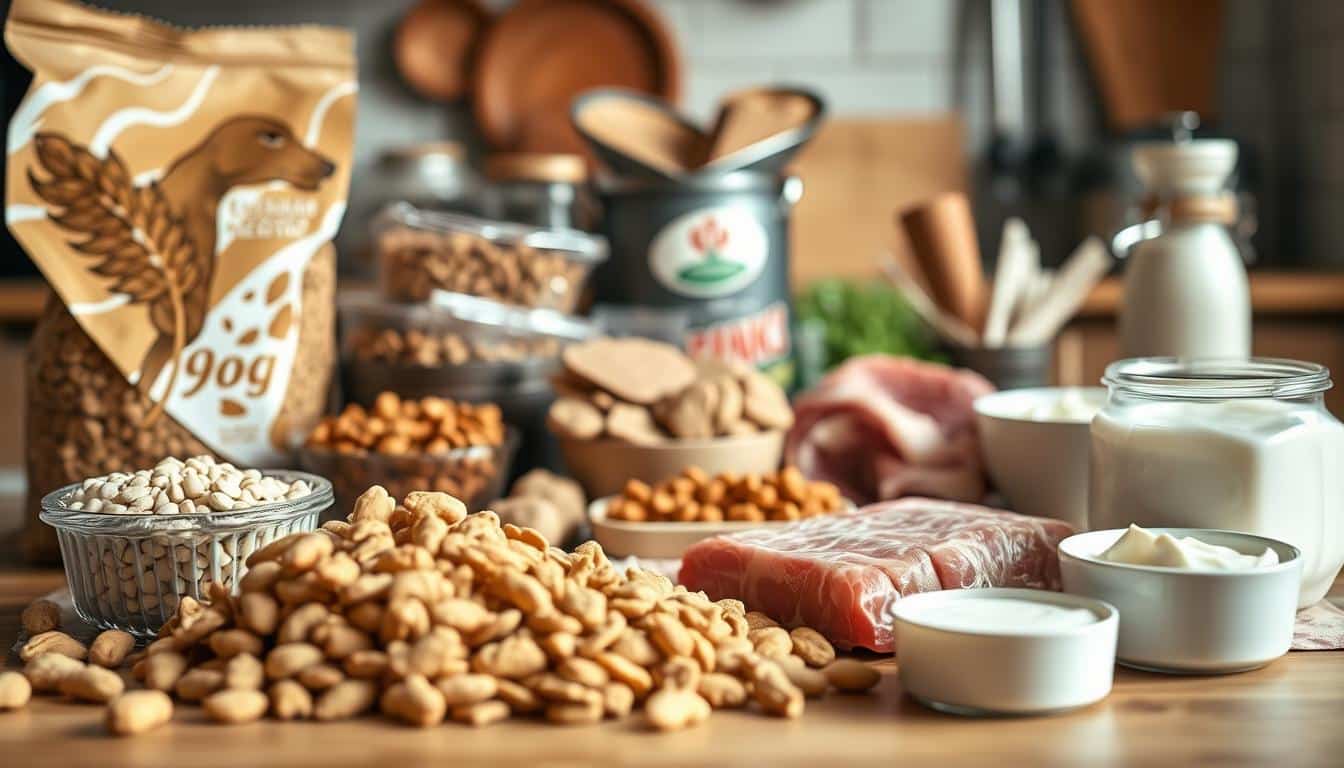Chronic otitis in dogs isn’t just annoying; it can really hurt them. Food allergies can cause ear issues, itching, and even hair loss. They may also lead to stomach problems, coughing, or sneezing due to certain foods like dairy, wheat, or beef.
Making a special diet for dogs with ear problems can give you control. Creating a homemade diet helps find and remove what’s causing the problem, improving their health. This approach allows trying new proteins and simple ingredients with your vet’s advice.
Always talk to your vet before switching your dog’s diet to ensure it’s balanced and safe. For yeast infections, lower carb and sugar foods, probiotics, and antifungal ingredients can help. This article provides helpful homemade dog food recipes and tips to help your dog heal and prevent future issues.
Understanding chronic ear infections in dogs and diet links
Ear infections in dogs can make both pets and their owners upset. These issues come up when the ear’s balance is disturbed, allowing organisms to grow too much. The link between diet and ear infections involves the immune system, gut health, and nutrients.
Types of ear infections: yeast versus bacterial
In vet clinics, two main types stand out. Dogs with yeast infections often have brown, smelly discharge and scratch a lot. Bacterial infections are different, causing yellow or green discharge, more pain, and a worse smell.
Vets are aware that yeast and bacteria usually live in ears harmlessly. Problems start when they multiply too much. This often happens in warm, moist places. It’s especially common in dogs with floppy ears or those with blocked air flow in their ear canals.
How diet influences ear microbiome and inflammation
A dog’s diet impacts their ear microbiome and overall inflammation. Foods high in simple carbs can feed yeast by increasing sugars. Low-quality food and gut issues can make infections happen more often.
Skin and ear issues can also come from protein intolerances and food sensitivities. These problems trigger the immune system. This makes ears more welcoming to yeast and bacteria.
Common symptoms that point to food-related ear problems
- Ear infections keep coming back despite treatment
- Lots of scratching, head shaking, and bad ear smell
- Paw licking or chewing, skin redness, and stomach issues
- Symptoms get better with special diets or changing food
If you notice these signs in your pet, it’s time to talk about diet with your vet. Catching this early can prevent permanent ear damage or hearing loss.
How food allergies and sensitivities trigger chronic ear infections
Food allergies can lead to ongoing ear issues in dogs. When dogs eat something they’re allergic to, their ears and skin can get inflamed. This can lead to non-stop scratching, head shaking, and ear discharge that over-the-counter ear drops can’t fix.
Dairy, wheat, eggs, soy, and beef are often to blame. These ingredients are common in many dog foods and treats. Switching your dog to a diet with new proteins or single ingredients can help identify the problem food.
Food intolerances can also make yeast problems worse in some dogs. This happens when an intolerance alters the dog’s gut, helping yeast to grow. If yeast takes over in a dog’s ears, it thrives on sugars and starches, making infections tough to fight.
Early-life antibiotics can change a dog’s gut health, increasing the chance of later allergies. This issue, along with a diet high in carbs, can lead to more yeast growth and ear problems. Eating foods with limited ingredients or new proteins can often minimize these issues.
Genetics also play a big part in food allergies. Some dog breeds are more likely to have these problems because of their genes. It’s good to know this when picking food for breeds prone to skin and ear conditions caused by their immune system.
Things in our environment can make food allergies worse. Stuff like household cleaners, pollen, dust mites, and fleas can affect the immune system. Watching these factors along with the dog’s diet can help find the real cause of ear problems.
- Typical allergens: dairy, wheat, egg, soy, beef.
- Protein link: protein intolerance dogs can promote yeast growth.
- Risk drivers: genetic risk allergies dogs and environmental allergy factors influence sensitivity.
Diagnosing food-related ear infections: vet tests and elimination diets
A stepwise veterinary approach is best for linking diet to chronic ear problems. First, do targeted tests to sort out infectious from food-induced issues. If these tests show a noninfectious cause, a structured diet trial can find the sneaky culprits.
Veterinary cytology and culture tests guide treatment decisions. Under the microscope, a stained slide reveals whether yeast or bacteria are to blame. When bacteria are found, ear culture sensitivity tests help pick the right antibiotic and spot drug-resistant types.
-
Ear cytology in dogs: quick slides show yeast, hyphae, or bacteria in moments.
-
Ear culture sensitivity: lab tests name the bacteria and suggest effective antibiotics.
Not all dogs need an elimination diet at first. Choose this route if allergies seem likely or infections keep coming back. A vet will help select a limited-ingredient or unique protein diet. This ensures nutrition during the trial.
-
Vets usually suggest trying the diet for 8 to 12 weeks for clear results.
-
Keep the diet strict: no treats, chews, flavored meds, or human food.
-
Write down any changes in ear condition, scratching, or discharge every week.
To find the problem food, reintroduce foods one by one and watch the ears. Adding foods slowly avoids mistakes and pinpoints the real issue. This methodical return tests each food’s effect carefully.
If ear swabs show too much yeast, focus on antifungal treatments and diet changes. When bacteria is found, use the ear culture results to choose the right treatment. Stay in touch with your vet to get the diagnosis and treatment right, especially when slowly adding foods back.
Designing a balanced homemade diet for ear-health support
Creating a homemade diet can improve chronic ear problems by avoiding triggers. It helps by giving the immune system what it needs. Make sure you keep things consistent, get advice from a vet, and introduce new things slowly. Here’s a guide to crafting meals that are easy on the stomach and good for ear and skin health.
Macronutrient targets for daily meals
Aim for a simple mix: about 50% protein, 25% starches, and 25% veggies. Also add some good fats and calcium. This combination is great for muscles, managing blood sugar, and reducing carbs that can cause yeast problems.
- Protein: choose whole meats like turkey, rabbit, or venison for each meal.
- Starches: opt for small amounts of rice or sweet potato, especially for yeast-sensitive dogs.
- Vegetables: pick veggies with low starch, like green beans, spinach, and zucchini.
- Fats and calcium: include fish oil for omega-3 and a vet-recommended source of calcium.
Choosing proteins and limited-ingredient approaches
Trying a new protein can reveal allergies and lessen ear issues. Stick to one protein at a time and keep the menu simple.
- Begin with just one protein, such as duck or venison.
- Opt for limited ingredient food, whether store-bought or homemade, to track allergens easily.
- If problems continue, a vet might suggest trying hydrolyzed protein options.
Role of healthy fats and omega-3s in inflammation control
Fats are key for healthy skin and ears. Choose fats rich in EPA and DHA to fight inflammation effectively.
- Fish oil is great for reducing swelling and pain in ears.
- Coconut oil, in small amounts recommended by a vet, can manage yeast.
- Make sure to balance the total fat to keep your dog’s diet in line with their needs.
Combine a thoughtful homemade diet with regular vet visits. Document what you feed your dog, any symptoms, and test results. This information helps adjust the diet correctly. It guides you in choosing between different diet plans safely over time.
Homemade diet for dogs with chronic ear infections
Creating meals at home lets you control what your dog eats. This helps find and cut out what causes their problems. Dog owners often see less ear issues when they skip common allergens and use fresh meats instead of dry food.
Why a homemade diet can help identify and remove triggers
Homemade food lets you try different ingredients one by one. It’s easier to see what causes your dog’s ear reactions. A test can show if removing beef, dairy, or wheat eases symptoms.
Food types to prioritize: novel proteins, low-carb, low-sugar options
Choose new protein sources like fish, pork, or lamb if common ones cause problems. A diet low in carbs helps fight yeast in ears. Focus on foods like lean meats, veggies low in starch, and healthy oils.
- Novel proteins: fish, duck, pork, rabbit.
- Low-carb choices: green beans, zucchini, leafy greens.
- Low-sugar swaps: avoid sweet potatoes and high-glycemic grains when managing yeast.
When to consider hydrolyzed or raw approaches under vet guidance
Hydrolyzed food might help when removal diets don’t work or for severe allergies. These diets simplify proteins to avoid immune reactions.
Raw diets can improve ear infections by focusing on meats and cutting carbs. Yet, raw food has risks like bacteria. Always talk to a vet and nutrition specialist before trying raw or homemade meals.
Keeping detailed records is key. Note down what your dog eats, their symptoms, and any treatment changes. This information helps your vet find the best food choice for your dog’s health, whether it’s homemade, hydrolyzed, or low-carb.
Recipes and meal ideas tailored for allergic or yeast-prone dogs
These recipes use simple ingredients to avoid common allergic triggers. They are tasty, balanced, easy to make, and checked by vets. You can use them in an elimination diet plan.

Ground turkey with vegetables and rice
- Ingredients: 1 lb ground turkey, 1/2 cup carrots, 1/4 cup broccoli, 1/4 cup cauliflower, 6 cups water, 1 tbsp coconut oil, 1 fish oil capsule, 1/2 cup rice.
- Method: Cook the turkey in coconut oil until it’s fully browned. Then add the chopped veggies and cook until they’re soft. Cook the rice separately, combine everything, add the fish oil once cool, portion, and refrigerate.
- Notes: This turkey recipe is great for dogs with allergies. It uses a unique protein and simple vegetables to prevent reactions. Pay attention to your dog’s reaction to this meal, especially ear itching.
Pork and veggie meatballs with omega-3 boost
- Ingredients: 1 lb ground pork, 3/4 cup mixed veggies (like broccoli, carrots, sweet potato, zucchini), 1 tsp ground flaxseed, 1.5 cups quick oats, 1/4 cup plain yogurt, 1 tsp coconut oil, 1 tsp fish oil.
- Method: Combine all the ingredients and shape into 1-oz meatballs. Bake at 350°F for 25 minutes. Let them cool before serving.
- Notes: These meatballs are enriched with omega-3 fats to help fight inflammation. They also have a bit of calcium from the yogurt. If your dog is dairy-sensitive, use dairy-free yogurt.
Pork and vegetable stew adapted for low-carbohydrate needs
- Ingredients: 1 lb pork cut into 1-inch pieces, 1 sweet potato, 1/2 cup chopped green beans, 1/2 cup chopped carrot, 1 tsp coconut oil, 1/4 cup almond meal.
- Method: Start by microwaving the sweet potato. Sauté the pork in coconut oil, cook the veggies, then make a roux with almond meal and water. Combine everything, simmer for 10 minutes, add fish oil when off the heat, cool, and serve.
- Notes: For a stew with less carbs, cut back on sweet potato and up the non-starchy veggies like green beans. This stew manages calories without adding sugar that feeds yeast.
Practical tips: Measure food portions according to your dog’s size. Change up the proteins often to reduce allergy risks. Keep a food diary to note any changes, specifically in ear symptoms. These dog food recipes help ease ear infections, avoid allergens, and assist in healing skin and ears.
Foods and ingredients to avoid when managing chronic ear infections
When managing chronic ear infections in dogs, diet choices matter a lot. First, take out obvious triggers. Then, look for hidden sources that feed yeast and inflammation.
Start by cutting out common allergens like dairy, wheat, egg, soy, and beef. Removing these can often help dogs with ear problems. Be aware, these allergens might be listed under different names in commercial formulas, so read labels carefully.
- Carbs and sugars that feed yeast: avoid white rice, potatoes, sweet potatoes, corn, peas, chickpeas, lentils, and sugary additives like dextrose, high-fructose corn syrup, honey, and maltodextrin.
- Processed kibble pitfalls: look for poor-quality fillers, artificial colors, and preservatives that harm gut balance. Low-grade grain meals often hide allergens and can worsen ear problems.
- Hidden allergens kibble: terms like “meat meal,” “animal digest,” or multiple unnamed proteins can mask dairy or beef traces.
Limit carbs and sugars. This move helps reduce the food yeast thrives on and may cut down inflammation in the ears.
Some human foods are really bad for dogs. Avoid giving them chocolate, grapes, raisins, onions, garlic in large amounts, and xylitol. These can cause severe health problems, not just ear infections.
Be cautious with herbs and supplements. Oregano and turmeric may help due to their antifungal properties, but the right dose is key. Garlic might help fight fungus, but it’s risky if not used correctly. Always check with your vet before introducing new herbs or supplements.
- Avoid cleaners and ear rinses with fragrances, dyes, or peroxide. Peroxide can trap moisture and worsen infections.
- Watch ingredient panels: a single “grain” listing can hide several carbohydrate sources that feed yeast dogs.
- If your dog eats table scraps, stop until you complete an elimination trial; many unsafe human foods dogs sneak into diets can confuse results.
Work with your vet or a nutrition expert to find out what triggers your dog’s ear infections. Removing items like high-sugar foods, processed fillers, and hidden proteins can give your pet a better chance to get better.
Supplements, probiotics, and functional foods to support ear health
Targeted supplements can reduce ear inflammation and help with gut health. Look for products that vets recommend and are safe to use. Combining these with ear cleaning and medical care can bring steady improvements.
Probiotics like Enterococcus faecium and Lactobacillus rhamnosus restore gut balance after antibiotics. Use a vet-approved probiotic with guaranteed live counts. Give probiotics apart from hot meals to keep the bacteria alive. Watch if your dog’s ear problems improve with probiotics.
- Stick with one probiotic product for four weeks.
- Try a synbiotic with both probiotics and prebiotic fiber.
- Avoid human supplements, especially those with xylitol.
Beneficial oils and antifungal additions
Omega-3 fats from fish oil can reduce swelling and help with skin care. Choose products high in EPA and DHA and follow the right dose. Coconut oil’s antifungal properties can also support skin health. Use it in moderation in your dog’s diet.
Functional foods like oregano and calendula may help with fungus issues. Before using turmeric, check if it’s safe for dogs. Always get your vet’s approval before trying new herbs or oils.
- Introduce one new oil or herb at a time.
- Only use pet-safe products or doses your vet suggests.
- If something causes upset or itching, stop using it.
When supplements can help immune support and when to consult your vet
Supplements can boost your dog’s health but they’re not a cure-all. Talk with your vet before starting any new supplements, especially with ongoing treatments. This helps ensure they’re safe and effective.
- Show your vet the supplement labels during visits.
- Use tests to see if the supplements are working.
- Halt supplements if your vet needs a clear test result.
With careful use, certain supplements can support your dog’s health plan. Always follow your vet’s advice to ensure everything you do is safe and helpful.
Transitioning safely to a homemade diet for dogs with ear issues
Changing your dog’s diet can help with yeast and ear swelling. Start with a plan for amounts, nutrients, and watching your dog. It’s important to change foods gently to prevent stomach problems and watch the ear issues get better.
- Start by slowly adding homemade food to your dog’s usual meals over 7–10 days. This slow introduction helps their stomach get used to it.
- Every 2–3 days, increase the homemade food and lessen the old food. Look at their stool and appetite to see if they’re adjusting well.
- If your dog starts vomiting or has severe diarrhea, stop the change and talk to your vet before continuing.
Portioning and balancing homemade meals vs. commercial feeding guidelines
Strive for a meal mix of 50% protein, 25% carbs, and 25% veggies. Then add needed fats and calcium. The right amounts ensure your dog gets all their nutrients and avoids health issues.
- Base the food amount on your dog’s current calorie needs, adjusting for their activity level and age.
- Weigh the ingredients and keep a food diary for precision. Use commercial food guidelines for calorie counts as you figure out homemade amounts.
- Check with a vet nutrition expert or your regular vet to make sure the food has enough calcium and other key nutrients.
Monitoring progress: what improvements to expect and when to seek help
Watch for less scratching, reduced smell and discharge, less redness, and ear healing. These improvements are what to look for as your dog gets better.
Allow 4–8 weeks to see real change. If things don’t get better or worsen, consider getting tests like cytology or sensitivity checks done.
- Write down any changes in how your dog acts, eats, or how their ears look.
- Know the urgent signs: ongoing pain, swelling, bad smell, or sudden hearing loss.
- Know when to call the vet if ear issues don’t clear up, get worse, or if new problems show up.
Complementary ear-care practices alongside dietary change
Combining diet changes with ear care can speed up recovery. It can also reduce the chance of getting sick again. Make sure to talk to your vet before starting any ear cleaning. Combining vet care, grooming, and home care helps keep dogs comfy.
Proper ear cleaning techniques and products to avoid
- A vet can show you how to check the ear and safely remove debris.
- Only use cleansers made for pets. Don’t use water or hydrogen peroxide in the ear. This is because they can cause irritation.
- Avoid products with dyes and fragrances. They can lead to allergic reactions.
- After cleaning, apply a drying agent suggested by your vet. This helps reduce moisture and yeast.
- If cleaning causes pain, stop and get advice from a vet. Pain might mean there’s an infection that needs treatment first.
Addressing environmental contributors: moisture, grooming, and ear hair
Moisture in the ear can cause yeast and bacteria to grow. It’s vital to dry ears after they get wet.
- Use a clean cloth to dry the outer ear. Use a drying solution if your vet agrees.
- Regular grooming can help by removing tangles and extra ear hair. Proper hair trimming helps airflow and reduces infection chances.
- Keep your dog’s play area dry. Try to keep their head from getting wet often. This is important for dogs that get ear problems a lot.
When to pursue cultures, sensitivity testing, and medical treatments
If ear infections keep coming back, talk to your vet about getting tests done. These tests can identify the cause and help choose the right treatment.
- Have a vet collect samples to avoid mistakes.
- Do the tests again if treatment doesn’t work or if you think there’s a resistant bug.
- Make sure to follow your vet’s advice closely. Don’t use medicines right after cleaning unless your vet says it’s okay.
- Talk about other options like enzyme cleaners or vet-approved treatments. Remember, natural products shouldn’t replace professional advice or tests when needed.
Conclusion
Making a homemade diet for dogs with ear infections lets owners pick the ingredients. This helps find out what causes the infections. It’s important to work with a vet to make sure the diet is balanced. Avoiding foods like dairy, wheat, and beef often shows if food causes the inflammation.
There’s a link between what a dog eats and their ear health, but food isn’t the only thing that matters. Finding out the exact cause, like yeast or bacteria, is key. This helps choose the right treatment. For yeast, less carbs and more meat might help, along with antifungal treatments. For bacteria, the right antibiotics and diet changes are needed.
To naturally deal with ear infections, combine good food with regular ear care. Keeping ears dry and checking them often helps too. Always talk to your vet to find the best food and care plan. This way, you can make changes if needed to keep your dog’s ears healthy.
FAQ
What is a balanced homemade diet for dogs with chronic ear infections?
How do yeast and bacterial ear infections differ and why does it matter for diet?
Can changing my dog’s food really help chronic ear infections?
Which food ingredients most commonly trigger ear-related allergy signs?
What carbohydrates and ingredients should I avoid if my dog has yeast-prone ears?
How does an elimination diet work and how long should it last?
What veterinary tests are needed to diagnose the cause of chronic ear infections?
Are homemade recipes safe and effective for allergy testing or long-term feeding?
Can supplements help my dog with chronic ear infections?
When should I consider a hydrolyzed or prescription diet instead of homemade or over-the-counter food?
What are practical homemade meals that can be used for allergy trials?
How do I transition my dog from kibble to a homemade or novel-protein diet safely?
What ear-care practices should accompany dietary changes?
How soon should I expect to see improvement after changing diet for yeast-associated ear infections?
Can antibiotics early in life affect later food sensitivities and ear infections?
Which breeds are more at risk for chronic ear infections and why?
Are raw diets a good option for dogs with chronic ear infections?
What signs indicate I should seek immediate veterinary care for my dog’s ear?
Content created with the help of Artificial Intelligence.



